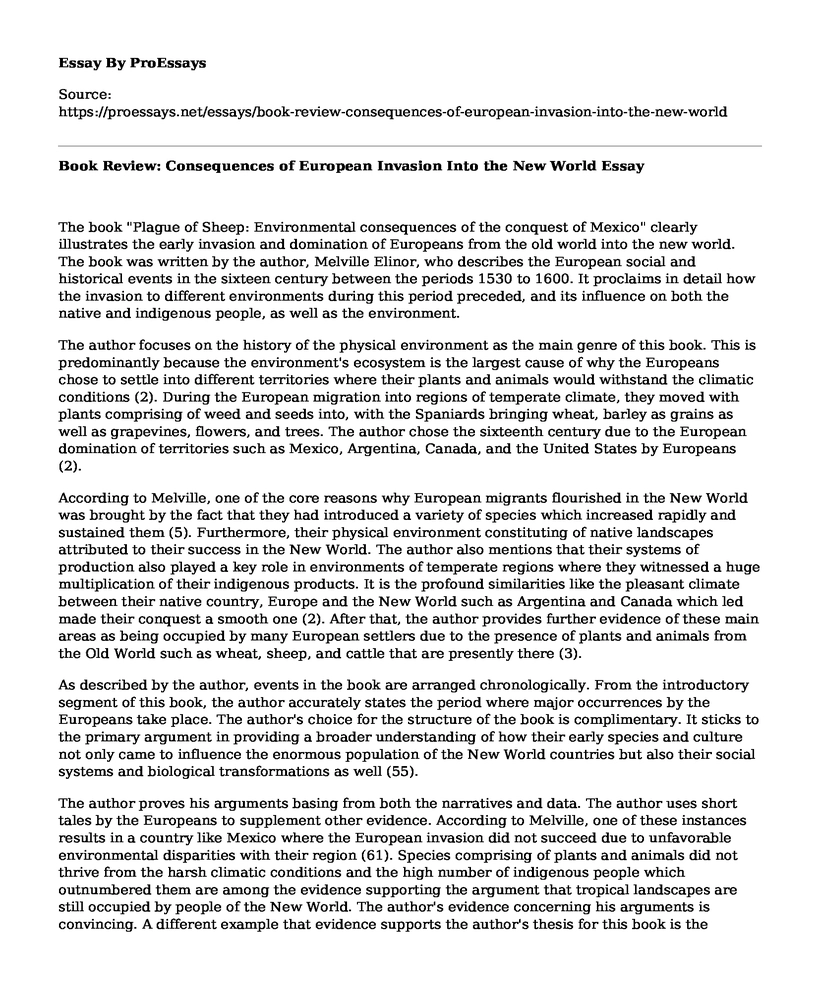The book "Plague of Sheep: Environmental consequences of the conquest of Mexico" clearly illustrates the early invasion and domination of Europeans from the old world into the new world. The book was written by the author, Melville Elinor, who describes the European social and historical events in the sixteen century between the periods 1530 to 1600. It proclaims in detail how the invasion to different environments during this period preceded, and its influence on both the native and indigenous people, as well as the environment.
The author focuses on the history of the physical environment as the main genre of this book. This is predominantly because the environment's ecosystem is the largest cause of why the Europeans chose to settle into different territories where their plants and animals would withstand the climatic conditions (2). During the European migration into regions of temperate climate, they moved with plants comprising of weed and seeds into, with the Spaniards bringing wheat, barley as grains as well as grapevines, flowers, and trees. The author chose the sixteenth century due to the European domination of territories such as Mexico, Argentina, Canada, and the United States by Europeans (2).
According to Melville, one of the core reasons why European migrants flourished in the New World was brought by the fact that they had introduced a variety of species which increased rapidly and sustained them (5). Furthermore, their physical environment constituting of native landscapes attributed to their success in the New World. The author also mentions that their systems of production also played a key role in environments of temperate regions where they witnessed a huge multiplication of their indigenous products. It is the profound similarities like the pleasant climate between their native country, Europe and the New World such as Argentina and Canada which led made their conquest a smooth one (2). After that, the author provides further evidence of these main areas as being occupied by many European settlers due to the presence of plants and animals from the Old World such as wheat, sheep, and cattle that are presently there (3).
As described by the author, events in the book are arranged chronologically. From the introductory segment of this book, the author accurately states the period where major occurrences by the Europeans take place. The author's choice for the structure of the book is complimentary. It sticks to the primary argument in providing a broader understanding of how their early species and culture not only came to influence the enormous population of the New World countries but also their social systems and biological transformations as well (55).
The author proves his arguments basing from both the narratives and data. The author uses short tales by the Europeans to supplement other evidence. According to Melville, one of these instances results in a country like Mexico where the European invasion did not succeed due to unfavorable environmental disparities with their region (61). Species comprising of plants and animals did not thrive from the harsh climatic conditions and the high number of indigenous people which outnumbered them are among the evidence supporting the argument that tropical landscapes are still occupied by people of the New World. The author's evidence concerning his arguments is convincing. A different example that evidence supports the author's thesis for this book is the introduction of endemic diseases from Europe into the New World. The author mentions that some illnesses such as Influenza and smallpox are popularly known to be in the Old World spread rampantly into even terrifying epidemics (10). This was just but the commencement of epidemic as it spread for a hundred more years in America, thereby reducing the indigenous population in that region. For this matter, Europeans had the competitive advantage to occupy the region quickly. Moreover, the author's thesis is also supported by the statement of Massachusetts first governor that the smallpox epidemic had swept out the natives and they possessed the new land (37).
The author relies on both primary and secondary sources to support his arguments. Primary sources that the author uses include manuscripts, archived data, and speeches (19). It is the most significant type of source to support the author's argument. This is because it allows the author to comprehensively explore the subject of environmental consequences in the New World by European domination (23). Contrary to this, primary sources do not allow the author to explore some instances as he describes in the book. Melville states that there is no statistical evidence why the smallpox epidemic flushed out an entire indigenous population in America which favored Europeans to acquire the Old World and transformed the land (4).
Conclusion
From this book, the author helps readers to understand the early dominance of Europeans into regions of tropical landscapes, known as the New World. While providing sufficient evidence, the author pinpoints crucial arguments which effectively elaborate those past happenings. The author's arguments also provide historical questions such as why people and animals of the New World succumbed to their massive due to a smallpox epidemic.
Work Cited
Melville, Elinor GK. A plague of sheep: Environmental consequences of the conquest of Mexico. Cambridge University Press, 1997.
Cite this page
Book Review: Consequences of European Invasion Into the New World. (2022, Aug 15). Retrieved from https://proessays.net/essays/book-review-consequences-of-european-invasion-into-the-new-world
If you are the original author of this essay and no longer wish to have it published on the ProEssays website, please click below to request its removal:
- Compare and Contrast Essay on Works of Arts About the Vietnamese War
- Essay Sample on US Military Intervention in Iraq
- Argumentative Essay Sample on Moral Justification of Japanese Bombing
- American Horizons Questions Paper Example
- The Rise of Charlemagne Paper Example
- Essay Sample on The Industrial Revolution: 1789-1914
- 78 Years Later: Gentrix Badoux's Story of the Pearl Harbour Attack - Research Paper







